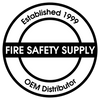Choose the Correct Fire Extinguisher
Posted by the FSS Team on Mar 14th 2024
A Comprehensive Guide to Choosing the Right Fire Extinguisher for Your Needs
When it comes to fire safety, having the right fire extinguisher on hand can make all the difference between a manageable situation and a disastrous one. Fires can arise from different sources, and not all fire extinguishers are created equal. To effectively combat fires, it's essential to choose the correct fire extinguisher type based on your specific needs and potential fire hazards. In this comprehensive guide, we'll walk you through the various fire extinguisher types and help you make an informed decision to protect lives and property.
1. Understanding Fire Classes
Fire extinguishers are categorized into different classes, each designed to handle specific types of fires. The classes are as follows:
- Class A: Suitable for ordinary combustibles such as wood, paper, cloth, plastics, and rubber.
- Class B: Designed for flammable liquids like gasoline, oil, grease, and alcohol.
- Class C: Effective against electrical fires, involving electrical equipment like appliances and wiring.
- Class D: Designed for fires involving combustible metals like magnesium, titanium, or sodium.
- Class K: Specifically for kitchen fires fueled by cooking oils and fats.
2. Assessing Fire Risks
Before choosing a fire extinguisher, conduct a thorough assessment of potential fire risks in your home, workplace, or establishment. Identify the types of materials present and the possible sources of ignition. For example, a restaurant kitchen will have different fire hazards than an office space. Understanding the specific risks will help you prioritize the most suitable fire extinguisher types.
3. Multipurpose ABC Fire Extinguishers
For general use and to cover multiple fire classes, ABC fire extinguishers are the most versatile choice. These extinguishers can handle fires involving ordinary combustibles (Class A), flammable liquids (Class B), and electrical fires (Class C). ABC extinguishers are commonly found in homes, offices, schools, and other commercial settings due to their broad range of applications.
4. Specialized Fire Extinguishers
In some cases, specific fire hazards may require specialized fire extinguishers. For instance:
- Class D Fire Extinguishers: These are essential for environments dealing with combustible metals, like laboratories or manufacturing facilities where such materials are used.
- Class K Fire Extinguishers: Commercial kitchens should have Class K extinguishers to combat fires involving cooking oils and fats.
5. Consider the Extinguisher Size
Fire extinguishers come in various sizes, denoted by their weight or capacity. Consider the size that suits your needs. Larger extinguishers provide more firefighting agent and last longer, but they might be heavier and more challenging to handle for some individuals. Smaller extinguishers are more portable and may be suitable for personal vehicles or small spaces.
6. Check for Certification and Compliance
Always ensure that the fire extinguisher you choose meets the necessary safety standards and certifications. Look for the "UL" (Underwriters Laboratories) mark or other relevant certifications from authorized bodies. Compliance with regulations ensures that the extinguisher has undergone rigorous testing and meets the required safety standards.
7. Training and Maintenance
Equipping yourself or your staff with proper training in fire extinguisher usage is crucial. Even the best fire extinguisher is ineffective if the user doesn't know how to operate it correctly. Additionally, schedule regular maintenance checks and inspections to ensure that the extinguisher is in optimal working condition when needed.
Choosing the right fire extinguisher is a critical aspect of fire safety. Understanding the various fire classes, assessing fire risks, and considering the extinguisher's size and certification are all essential factors. By making an informed decision and providing proper training, you can effectively protect against potential fire hazards, safeguard lives, and protect property. Remember, fire prevention and preparedness are keys to ensuring a safer environment for everyone.
 Since 1999, Fire Safety Supply has been the go-to for fire suppression products, industrial dry chemical systems, high and low-pressure CO2, vehicles, and clean agents. We serve various types of industries such as restaurants, commercial kitchen, wineries, and more.
Since 1999, Fire Safety Supply has been the go-to for fire suppression products, industrial dry chemical systems, high and low-pressure CO2, vehicles, and clean agents. We serve various types of industries such as restaurants, commercial kitchen, wineries, and more.
